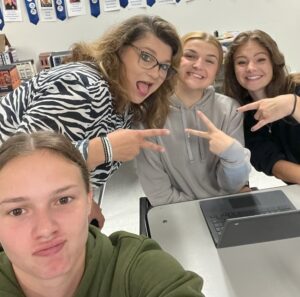
One of the most common questions I get on my DMs and emails is ‘How do you teach without PowerPoints?‘ The short answer…STUDENT LED INSTRUCTION!
What is the student-led strategy? Ten years ago I stopped teaching to PowerPoints because it was just too much talking for me. I usually teach 5 or 6 preps every semester! Today’s students won’t stay off their phones long enough to listen while they are being lectured. I needed a solution!
What is the difference between teacher-led and student-led learning?
A teacher led classroom is when the teacher is delivering the information by talking…a lot…and usually standing in front of boring PowerPoints. In the above YouTube video, I illustrate how student-led instruction happens in my classroom. Student-led instruction is when students research the answers, then report their findings to the class. Student-led instruction keeps students engaged and involved in the learning process and keeps them off their cell phones. When students know that they are responsible for material during a time frame, they will work because they know that they will be called on to present…or “lead”. And no more boring lectures…instead I act as their coach on the sideline. Student led instruction also get students used to working and communicating in groups and presenting in my classroom.
Episode #2 of my podcast ‘The Art of Teaching Business‘ is titled ‘Student-Led Instruction‘
Uncover the secrets of student-led instruction and how it revolutionizes traditional teaching methods. Empower your students to become leaders, problem solvers, and innovators.
My podcast ‘The Art of Teaching Business‘ is available here on my website and at all major podcasting outlets including Apple Podcasts and Spotify.
What are examples of student-led activities?
Active Learning: In student-led instruction, the emphasis shifts from teachers imparting knowledge to students actively seeking and acquiring knowledge. This approach encourages critical thinking, problem-solving, and curiosity, fostering a deeper understanding of the subject matter.
Ownership of Learning: When students are responsible for their research and presentations, they take ownership of their education. This sense of responsibility can motivate students to explore topics more deeply, as they are personally invested in the learning process.
Collaboration and Communication Skills: Students learn not only from their research but also from their peers. Collaborative group work and presentations improve communication skills, teamwork, and the ability to convey complex ideas effectively.
Student-led instruction offers numerous benefits for both students and educators:
Enhanced Engagement: Students are more engaged when they have an active role in their learning, leading to better retention of information and a more enjoyable learning experience.
Critical Thinking Skills: This approach encourages critical thinking, problem-solving, and creativity, which are essential skills in the 21st century.
Preparation for the Real World: Student-led instruction mirrors real-world scenarios where individuals must research, collaborate, and present findings, preparing students for future careers.
Diverse Perspectives: Students bring their unique perspectives and interests to the classroom, enriching discussions and broadening the scope of learning.
What is student-led or student directed learning? Student-led instruction represents a paradigm shift in education, empowering students to become active participants in their learning journey. By relinquishing the traditional role of lecturer, teachers create an environment where curiosity, critical thinking, and collaboration flourish. Students aren’t just passive recipients of knowledge; they are the creators of knowledge. As we continue to embrace innovative approaches to education, student-led instruction stands as a powerful tool for fostering lifelong learners who are prepared to thrive in an ever-changing world.
My freebie vault has over 15 FREE RESOURCES for your classroom when you subscribe to my newsletter.
